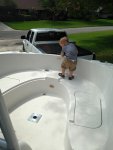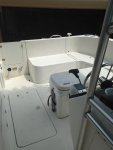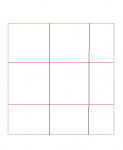jkimball
Petty Officer 1st Class
- Joined
- May 14, 2013
- Messages
- 220
So, I?m looking for a little advice on re-coring a section of my deck.
I had about ? of my deck replaced before Thanksgiving on my boat. The deck had some pretty significant soft spot from hardware that wasn?t properly sealed and a T-Top that wasn?t sealed at all and used lag bolts to install it (previous owner) and the deck is the only problem area. The surveyor when I bought the boat said stringers & transom were solid and not to worry about them. So I knew what I was getting into.
So, back to the replacement. As I said, I had ? of it done earlier, and only have a very small 2? x 3? section up front between the seats where the table mounts left to replace.
I originally hired a guy to do it, and he gave me a fantastic price, and did excellent work ? the only catch is he isn?t reliable. He said he?d have the whole thing done in 2 weeks, and I ended up having to take it to him twice to piecemeal it together for 3 weeks at a time.
So after the last one, since the section is so small ? I decided to cut my losses and repair it myself.
I?m no stranger to fiberglass work as I?ve laid glass for other things in the past, and I?m a pretty handy DIYer so I can handle the work myself, but I just need some direction on what products, epoxies, resins etc. to use.
My plan is to cut the outer skin off with my oscillating tool, dig out the old rotten balsa core, lay epoxy or whatever is called for, put in new ?? Marine Grade Ply (sealed on both sides with epoxy), sand/grind a 12:1 bevel on the cut area and replace the skin on the new core. Then I would I suppose use strips of glass to seal the cut area, sand smooth and roll on my new kiwi grip. Does this process sound accurate? And am I correct in assuming I could just bed the current skin to the new core using epoxy & weight it down overnight or until cured, or would I need to use some sort of fasteners? Ideally I don?t want to put anymore holes in the core than I have to.
So, if someone could please help me to know what I need of the following that would be great:
Epoxy/Resin: what type or brand do you suggest
Glass Mat: What type, brand, weight etc.
Do I need anything else?
Thanks in advance for the help!
I had about ? of my deck replaced before Thanksgiving on my boat. The deck had some pretty significant soft spot from hardware that wasn?t properly sealed and a T-Top that wasn?t sealed at all and used lag bolts to install it (previous owner) and the deck is the only problem area. The surveyor when I bought the boat said stringers & transom were solid and not to worry about them. So I knew what I was getting into.
So, back to the replacement. As I said, I had ? of it done earlier, and only have a very small 2? x 3? section up front between the seats where the table mounts left to replace.
I originally hired a guy to do it, and he gave me a fantastic price, and did excellent work ? the only catch is he isn?t reliable. He said he?d have the whole thing done in 2 weeks, and I ended up having to take it to him twice to piecemeal it together for 3 weeks at a time.
So after the last one, since the section is so small ? I decided to cut my losses and repair it myself.
I?m no stranger to fiberglass work as I?ve laid glass for other things in the past, and I?m a pretty handy DIYer so I can handle the work myself, but I just need some direction on what products, epoxies, resins etc. to use.
My plan is to cut the outer skin off with my oscillating tool, dig out the old rotten balsa core, lay epoxy or whatever is called for, put in new ?? Marine Grade Ply (sealed on both sides with epoxy), sand/grind a 12:1 bevel on the cut area and replace the skin on the new core. Then I would I suppose use strips of glass to seal the cut area, sand smooth and roll on my new kiwi grip. Does this process sound accurate? And am I correct in assuming I could just bed the current skin to the new core using epoxy & weight it down overnight or until cured, or would I need to use some sort of fasteners? Ideally I don?t want to put anymore holes in the core than I have to.
So, if someone could please help me to know what I need of the following that would be great:
Epoxy/Resin: what type or brand do you suggest
Glass Mat: What type, brand, weight etc.
Do I need anything else?
Thanks in advance for the help!

























